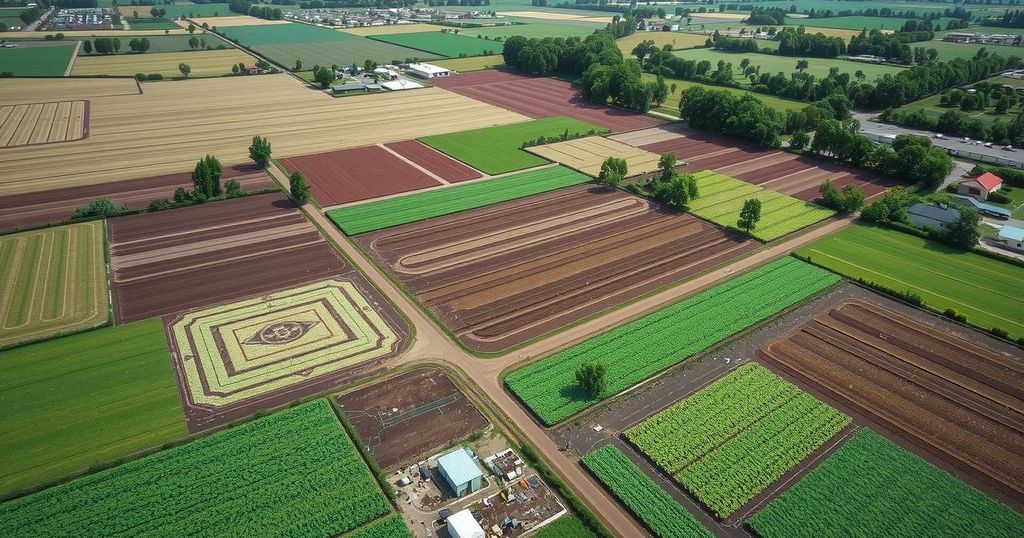Farmers Struggle to Recover from Hurricane Helene’s Devastation

Farmers in the South are still struggling months after Hurricane Helene caused catastrophic damage to crops and infrastructure, resulting in losses exceeding $10 billion. The hurricane significantly impacted Georgia’s agricultural sector, particularly during crucial harvest times for cotton, leading to both emotional and financial distress for farmers who now face daunting recovery tasks.
Farmers in the South continue to face significant challenges months after Hurricane Helene inflicted severe damage to their crops. As of December, twisted equipment and broken irrigation systems still litter fields across Georgia. The hurricane, which made landfall in late September as a Category 4 storm, destroyed not only crops but also farm infrastructure and timber. Chris Hopkins, a farmer in Toombs County, expressed the emotional toll of recovery efforts and uncertainty about the future.
Helene’s path of destruction has led to estimated losses exceeding $10 billion across the region, impacting farmers from Florida to Virginia. The storm struck during critical harvest times for cotton and other crops, leaving many farmers to postpone cleanup in hopes of salvaging remaining yields. Estimates place the storm’s damage at approximately $630 million for Virginia, $452 million for South Carolina, and $162 million for Florida.
On his 1,400 acres, Hopkins reported losing about half of his cotton crop due to the hurricane’s timing and conditions. Despite having insurance, he anticipates a loss of $430,000, excluding costs related to machinery repairs and debris removal. The storm also devastated pecan orchards and fields prepared for fall vegetables. The impacts were felt far beyond the hurricane’s center, with tropical storm-force winds reaching considerable distances and significantly affecting local agricultural operations across several states.
In response to the disaster, Georgia officials allocated $100 million for emergency loans to aid farmers in recovery efforts while addressing the constraints of state constitutional provisions regarding disaster relief. Meanwhile, Congress is debating additional federal aid for those affected.
Farmers like Jeffrey Pridgen, who raises chickens in Coffee County, were not spared from Helene’s wrath. The destruction of poultry houses has left him in a precarious financial position, and he remarked on the dramatic loss of income and retirement funds.
The poultry industry, particularly in Georgia, faced substantial hits totaling approximately $683 million, with numerous houses needing rebuilding and repair. However, some experts suggest that overall consumer prices will not significantly rise due to the ability of other regions to compensate for the lost crops, except for pecans, where Georgia retains a major share of U.S. production.
The cumulative disruptions and losses from Hurricane Helene introduce significant strain on farmers who continue to cope with the aftermath. The enduring emotional and financial impacts may persist long after the storm has passed, necessitating ongoing support and recovery efforts in the agricultural sector.
Hurricane Helene, which struck the continental United States as a major Category 4 hurricane in late September 2024, had devastating consequences for agriculture across the southeastern states, particularly in Georgia. The storm’s timing coincided with critical harvesting periods for cotton and various crops, leading to significant agricultural losses and damage to farm infrastructure. As farmers grappled with cleanup and recovery, the economic impact of Helene estimated at over $10 billion left many contemplating the future of their farming operations.
In conclusion, Hurricane Helene’s impact on southern agriculture has been profound, with farmers facing enormous losses and emotional distress. The storm disrupted critical harvest periods and devastated crops, infrastructure, and livelihoods, leading to an extensive multi-billion dollar economic toll for the agricultural sector. Ongoing recovery efforts and support from both state and federal entities remain essential to aid farmers as they work to rebuild and stabilize their operations.
Original Source: mynorthwest.com






